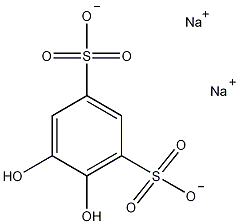
Structural formula
| Business number | 03XT |
|---|---|
| Molecular formula | C6H4Na2O8S2.H2O |
| Molecular weight | 332.22 |
| label |
ferrotitanium reagent, Sodium catechol-3,5-disulfonate, titanium reagent, Try titanium spirit, Disodium 1,2-dihydroxybenzene-3,5-disulfonate, 4,5-Dihydroxy-1,3-benzenedisulfonic acid disodium salt, 1,2-Dihydroxy-3,5-benzenedisulfonic acid disodium salt, 4,5-Dihydroxy-1,3-benzenedisulfonic acid disodium salt, Tiron, Pyrocatechol-3,3-disulfonic acid disodium salt, developer, masking agent |
Numbering system
CAS number:149-45-1
MDL number:MFCD00007473
EINECS number:205-741-5
RTECS number:CZ9263000
BRN number:4629740
PubChem number:24889224
Physical property data
1. Physical property data:
1. Appearance: White powder
2. Melting point (ºC): 300 ºC3. Solubility: Easily soluble in water , slightly soluble in alcohol, insoluble in acetone and ether.
Toxicological data
II. Toxicological data:
1. Acute toxicity: mouse abdominal LC50: 6060 mg/kg
2. Reproductive toxicity: small Mouse abdominal TCLo: 30 gm/kg
Ecological data
3. Ecological data:
Other harmful effects: This substance may be harmful to the environment, and special attention should be paid to water bodies.
Molecular structure data
None
Compute chemical data
IV. Calculated chemical data:
1. Number of hydrogen bond donors: 2
2. Number of hydrogen bond acceptors: 8
3. Number of rotatable chemical bonds: 0
4. Topological molecular polar surface area (TPSA): 155
5. Number of heavy atoms: 18
6. Surface charge : 0
7. Complexity: 413
8. Number of isotope atoms: 0
9. Determine the number of atomic stereocenters: 0
10. The number of uncertain atomic stereocenters: 0
11. The number of determined chemical bond stereocenters: 0
12. The number of uncertain chemical bond stereocenters: 0
13. Number of covalent bond units: 3
Properties and stability
Stable under normal temperature and pressure.
Incompatible materials: strong oxidizing agents
Storage method
Store sealed in a dry and cool place.
Synthesis method
1. Prepare by heating 5-bromo-4-hydroxyisophenylenedisulfonic acid and caustic soda in water, and then acidifying the product with HCl.
2.Slowly mix 1 part of catechol and 5 parts of fuming sulfuric acid until completely dissolved, heat in a water bath until solid, Keep it warm for 4 hours, then slowly add water to completely dissolve it, filter to obtain a clear filtrate, add refined sodium chloride, dissolve the precipitated crystals with distilled water, add activated carbon, boil, and filter while hot. Add barium carbonate to the filtrate, filter out the precipitate, then add sodium carbonate, stir and filter, the filtrate is concentrated under reduced pressure, filter out the crystallized sodium chloride after cooling, and the filtrate is re-concentrated and dried at 80°C to obtain the finished product. The process reaction is:


Purpose
1. Used as an intermediate in organic synthesis.
2. Used for colorimetric determination of titanium, iron and molybdenum.
3.Used as a chromogen for the spectrophotometric determination of rare earth elements manganese, titanium, cerium, niobium and molybdenum. It is also used as an indicator for titration and as a masking agent for metal ions.


